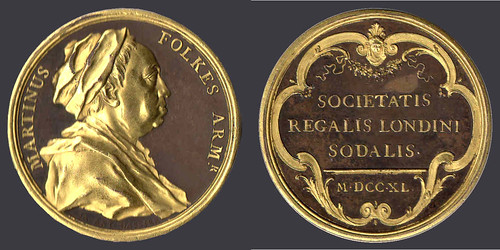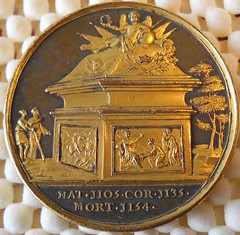
PREV ARTICLE
NEXT ARTICLE
FULL ISSUE
PREV FULL ISSUE
STILL MORE ON DAMASCENED MEDALS

In a follow-up to Philip Mernick and Christopher Eimer's responses on damascened medals, Dick Johnson asked me to forward them this note: Can either of you describe how the damascene gold was applied if these medals were made in the 18th century? As a coin and medal technologist I like to learn HOW such items were made. I surmised -- possible incorrectly -- that these were restrikes and made by electroplating the gold on a medal that was first bronzed (for the dark patina), then masked off before goldplating. That is the most logical method I could imagine. That is how they could be made today. However, if you can document these were, indeed, made with the damascene gold in the 18th century when these medals were first issued, can you tell me HOW this was accomplished? If the gold leaf was applied as Chris suggests, how was it applied to only the relief surfaces? It the gold leaf was applied to the entire surface, it would then require chasing to remove it from the background or field. This would be a very tedious chore and very time-consuming for an issue of any quantity of medals. Could the gold leaf be applied to the die before striking and then removed from the field (which would be the high surface on the die), then struck for the gold to adhere to the medal's surface? Have either of you seen any of this gold surface flaked off, or removed (to bleed and show the surface under the gold)? I am trying to acquire the specimen from my local coin dealer that prompted this discussion Then I will scratch off some of that gold to reveal the under surface. That should provide a clue.
While there is no doubt in my mind that the damascened medals of Dassier are authentic eighteenth-century productions, my knowledge of the procedure is somewhat sketchy. My basic understanding is that the entire surface of the medal is gold-leafed, and the gold leaf in the areas that do not constitute the relief is then removed. William Eisler has written extensively on the Dassier family and their medals and would I think be far more qualified to provide an explanation of the procedure. Philip Mernick writes: By coincidence Tuesday's lecture at the Royal Numismatic Society here in London was by William Eisner on the subject Jean Dassier and his Rois d'Angleterre (medals). Mr Eisner, originally from New York but resident in Lausanne, Switzerland for many years, explained the role that religion and politics played in Dassier's promotion of this series of medals. He made it clear that damascened bronze was one of the options offered from the start, in the 1720s, the others being bronze, silver and gold, although the latter were never produced. I took the opportunity of asking Mr Eisner about the damascening process. He said that he did not know how they were made although examination of damaged specimens indicates that the gold was applied over the bronzed finish. He also told us that Dassier was not the first to offer damascened medals - the process having been used in the 1670s for a French series of medals. This could, I suppose, have been Mauger's Histoire Metallique series. He said the 1740 Martin Folkes medal was the first of a new series issued by Jean Dassier's son Jacques-Antoine Dassier (1715-59).
Thanks, everyone! This is great information. Dick Johnson has a follow-up.
-Editor
Dick Johnson writes:
I am further appreciative of his mentioning that the bronzing of each of these damascene medals is UNDER the gold. I was going to scrape off some of the gold on my new acquisition to determine if the bronze was indeed under the gold -- and therefore applied before the gold leaf was applied. Now I don't have to and my medal can now remain intact. I accept all three gentlemen's assertion that the gold was applied as gold leaf, and the portion that reveals the bronzed patina underneath was somehow removed (although no one knows, it seems, how this was accomplished). Also I accept that the medals are not restrikes (after which they could have been goldplated). So my early theory has now been disproven. Thank you to each numismatist who favored E-Sylum readers with your wisdom: Christopher Eimer, Philip Mernick, and William Eisner. You are to be commended.
To read the earlier E-Sylum article, see:
MORE ON DAMASCENED MEDALS
(www.coinbooks.org/esylum_v14n11a10.html)
The Numismatic Bibliomania Society is a non-profit organization promoting numismatic literature. See our web site at coinbooks.org. To submit items for publication in The E-Sylum, write to the Editor at this address: whomren@gmail.com To subscribe go to: https://my.binhost.com/lists/listinfo/esylum All Rights Reserved. NBS Home Page Contact the NBS webmaster 
|
